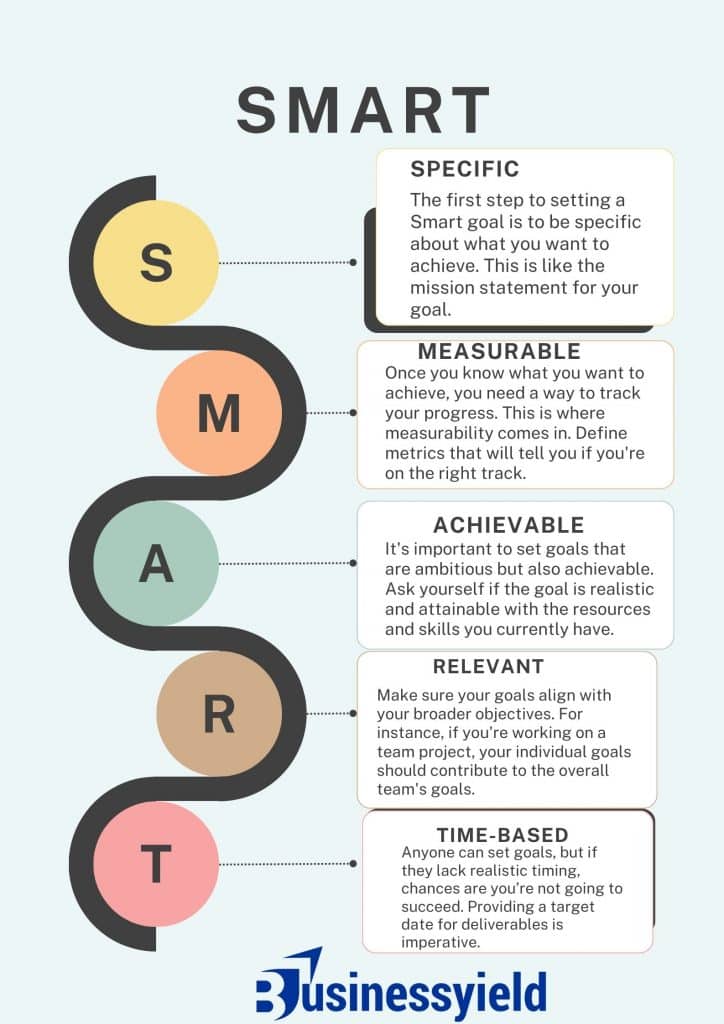Ever found yourself setting a goal, putting all your effort into it, only to hit a roadblock halfway through? Perhaps it was something like “get fit” or “learn a new language.” While these aspirations sound promising, they often lack clarity, making it tough to gauge progress and stay motivated. This is where SMART goals come into play. They serve as a powerful tool for individuals striving to transform dreams into reality.
This guide aims to provide you with the necessary tools to formulate impactful SMART goals and free templates to view and. We’ll go into each component – specific, measurable, achievable, relevant, and time-bound and demonstrate how to apply them to your ambitions. By the end, you’ll be adept at crafting SMART goals, poised to confront any challenge and revel in your achievements along the way.
Key Points
- Smart goals is a concept introduced by George T. Doran in 1981, offers a structured approach to goal setting, enhancing the likelihood of achievement
- SMART acronym serves as a widely recognized framework for crafting effective goals.
- Setting and sharing SMART goals is a win-win for clear communication and a motivated team.
- Setting achievable goals is essential for staying motivated and on track. When you achieve a goal, it gives you a sense of accomplishment and motivates you to keep moving forward.
Smart goal template
Did you ever set a goal and feel super motivated, then…fizzled out somewhere along the way? Yeah, me too. That’s where SMART goals come in. Also, they’re a game-changer for turning those fuzzy dreams into real achievements. Think of SMART goals as a recipe for success.
This concept introduced by George T. Doran in 1981, offers a structured approach to goal setting, enhancing the likelihood of achievement.
SMART acronym serves as a widely recognized framework for crafting effective goals. The acronym SMART stands for specific, measurable, achievable, relevant, and time-bound. Let’s go into each component to grasp how they enhance goal-setting proficiency:

Specific
The first step to setting a Smart goal is to be specific about what you want to achieve. This is like the mission statement for your goal. Don’t worry about the nitty-gritty details of how you’ll get there just yet, but focus on answering the following questions:
- Who: Consider who needs to be involved to achieve the goal. This is especially important for group projects. For instance, if your goal is to improve the customer service experience at your company, you’ll need to involve employees from different departments, such as sales, marketing, and customer support.
- What: Be clear about exactly what you’re trying to accomplish. Don’t be afraid to get detailed! For example, instead of saying “I want to get in better shape,” a more specific goal could be “I want to lose 10 pounds by running 3 times a week for 3 months.”
- When: You’ll get more specific about timing later, but set a general timeframe for now. Is this a short-term goal that you want to achieve in a few weeks or months, or a long-term goal that will take a year or more?
- Where: This question might not apply to all goals, but identify a location or relevant event if it’s important. For example, if your goal is to improve your public speaking skills, you might set a goal to join a Toastmasters club meeting in your area.
- Which: Think about any obstacles or requirements. Are there any skills you need to develop to make this goal achievable? For example, if your goal is to learn a new language, you’ll need to identify the resources you’ll need, such as a language learning app or a tutor.
- Why: What’s the motivation behind your goal? Understanding the ‘why’ can help you stay committed. For example, if your goal is to improve your public speaking skills, your motivation might be to feel more confident giving presentations at work.
By answering these questions, you’ll create a clear picture of what you’re aiming for and increase your chances of success.
Measurable
Once you know what you want to achieve, you need a way to track your progress. This is where measurability comes in. Define metrics that will tell you if you’re on the right track. Here are some tips for setting measurable goals:
- Quantify your goal whenever possible. For example, instead of saying “I want to improve my writing skills,” you could set a goal to “Improve my writing score by 2 points on the next writing assessment.”
- Set milestones along the way. If your goal is a large project that will take time to complete, break it down into smaller, more manageable tasks. Then, set deadlines for each milestone. This will help you stay on track and motivated.
- Track your progress regularly. There are many ways to track your progress, such as keeping a journal, using a goal-tracking app, or creating a visual chart. Regularly monitoring your progress will help you identify areas where you need to make adjustments and celebrate your successes.
By setting measurable goals, you’ll be able to stay accountable and motivated throughout the goal-setting process.
Achievable
It’s important to set goals that are ambitious but also achievable. Ask yourself if the goal is realistic and attainable with the resources and skills you currently have. If not, what steps can you take to develop those skills? Here are some tips for setting achievable goals:
- Be honest with yourself about your current skills and limitations. Don’t set a goal that is so out of reach that you’re guaranteed to fail.
- Break down large goals into smaller, more manageable steps. This will make the goal seem less daunting and increase your chances of success.
- Focus on your strengths. What are you good at? Leverage your existing skills and experience to set goals that you’re confident you can achieve.
- Be willing to adjust your goals as needed. As you work towards your goals, you may find that some adjustments are necessary. Be flexible and willing to adapt your goals based on your progress and circumstances.
Setting achievable goals is essential for staying motivated and on track. When you achieve a goal, it gives you a sense of accomplishment and motivates you to keep moving forward.
Relevant
Make sure your goals align with your broader objectives. For instance, if you’re working on a team project, your individual goals should contribute to the overall team’s goals. Here are some tips
In summary, adopting the SMART framework empowers goal-setting by fostering specificity, measurability, achievability, relevance, and time-bound parameters. Additionally, by integrating these elements, individuals and teams can optimize their goal-setting endeavors, enhancing focus, accountability, and ultimately, success.
Time-Based
Anyone can set goals, but if they lack realistic timing, chances are you’re not going to succeed. Providing a target date for deliverables is imperative. Ask specific questions about the goal deadline and what can be accomplished within that time period.
Also, if the goal will take three months to complete, it’s useful to define what should be achieved halfway through the process. Providing time constraints also creates a sense of urgency.
Free smart goal template
Crafted to empower individuals like yourself, this template serves as a structured roadmap toward achieving your objectives effectively. With its user-friendly layout and customizable features, it facilitates a clear and concise articulation of your goals, enabling you to delineate actionable steps and track your progress effortlessly.
Whether you’re aiming to enhance your productivity, foster healthier habits, or advance your career, this tool equips you with the structure and support needed to turn your aspirations into tangible achievements. So why wait? Take the first step towards realizing your dreams today with these free smart goal template
BusinessYield Smart Goal Templates
Pros and Cons of SMART Goal
Let’s analyze the pros and cons of SMART goals.
Pros of SMART Goals
Imagine this: you and your team are working on a project. Everyone’s hustling, but there’s a nagging uncertainty – are we actually on the right track? SMART goals can banish that doubt. Here’s why:
#1. Clear Communication
No more ambiguity! SMART goals are specific, meaning everyone involved knows exactly what success looks like. This fosters a sense of alignment, think of a team rowing in perfect sync. Research shows that employees who understand how their work contributes to bigger goals are twice as motivated! Setting and sharing SMART goals is a win-win for clear communication and a motivated team.
#2. Project Clarity
Have you ever finished a project unsure if you achieved your goals? SMART goals eliminate that confusion. They force you to define clear success criteria, so there’s no room for misinterpretations. It’s like having a finish line painted in neon, you know exactly where you’re headed.
#3. Actionable Roadmap
With SMART goals, you’re not just setting aspirations, you’re creating a concrete plan. Specific goals outline what you want to achieve, measurable goals define how you’ll track progress, achievable goals ensure you’re not setting yourself up for failure, relevant goals keep you focused on what matters, and time-bound goals establish deadlines to keep you on track. It’s like having a map with clear directions and checkpoints, you know what to do and when to do it.
#4. Resourceful Allocation
Imagine being a manager with a limited budget and team. SMART goals make your life easier! They provide a clear picture of what needs to be achieved, allowing you to allocate resources, staff, budget, and even time – efficiently. It’s like having a budget for your project, ensuring you have the tools you need to succeed.
#5. Motivation & Career Growth
SMART goals aren’t just about project success, they’re about people too. When goals are achievable and relevant, it boosts team morale. Plus, achieving SMART goals often requires acquiring new skills. This creates opportunities for individual career development, which is a win for both you and your team.
Cons of SMART Goals
SMART goals are fantastic, but they’re not perfect. Here are some potential drawbacks to consider:
#1. Oversimplification Trap
While the SMART framework is great for clarifying objectives, it can sometimes oversimplify complex goals. Imagine trying to squeeze a giant, multifaceted project into a tiny SMART box. It might not fit. If your goal is intricate, consider breaking it down into smaller, more manageable SMART goals.
#2. Short-Sighted Focus
SMART goals emphasize time-bound objectives, which can be fantastic for immediate projects. However, this focus on the short term might discourage long-term vision. If that’s a concern, consider creating a vision statement alongside your SMART goals. Think of it as the big picture that guides your smaller, time-bound objectives.
#3. Creativity Constraint
Sometimes, the most innovative ideas come from unexpected places. SMART goals, with their focus on specific tasks, can unintentionally stifle creativity. Imagine feeling so boxed in by your SMART goals that you miss out on a game-changing idea.
#4. Narrowed Perspective Danger
Being laser-focused on achieving SMART goals is great, but it can also lead to a narrowed perspective. Imagine your team working so hard on their specific goals that they lose sight of the bigger picture – the organization’s overall strategic goals. To avoid this, make sure to connect your SMART goals back to those broader objectives. This way, everyone understands why their specific tasks matter and how they contribute to the company’s success.
#5. Resource Intensity
For smaller teams, the emphasis on measurable outcomes in SMART goals can feel overwhelming. Tracking those metrics often requires specialized analytics tools, which can be
What is a SMART goal example?
Imagine you’re setting a goal to increase sales for your business. A SMART goal example could be: “Our team aims to boost quarterly sales revenue by 15% within the next six months. The sales and marketing departments will collaborate on targeted advertising campaigns, expand our online presence, and offer special promotions.
Achieving this goal will not only increase our market share but also enhance brand visibility and profitability. By setting a specific target (15% increase), establishing a clear timeframe (within the next six months), involving relevant teams (sales and marketing departments), and outlining actionable steps (advertising campaigns, online expansion, promotions), this goal becomes SMART.
Specific, measurable, achievable, relevant, and time-bound, providing a clear roadmap for success. This example illustrates how SMART goals can guide organizations towards tangible outcomes and drive progress in a structured manner.”
How do you answer SMART goal questions?
Answering SMART goal questions feels a lot smoother when you break them down into these five key areas. First, think specific. What exactly do I want to improve on? Instead of saying, “Get better at public speaking,” I could aim to “deliver a presentation to my department without fidgeting by next quarter.” That’s clear and focused.
Next comes measurable. How will I know I’m making progress? The numbers are great here. Maybe I’ll track “reduce the number of ‘um’s’ in my presentations by 50%.” If numbers aren’t feasible, describe it: “feel more confident holding eye contact with the audience.”
Being attainable is important, I shouldn’t set myself up for failure. Be honest about my current skills and resources. Can I realistically achieve that goal within the timeframe? Maybe giving a presentation in front of the entire company right away isn’t attainable, but the department goal is a good start.
Relevant ensures the goal matters. Why am I doing this? “Improve public speaking skills” might sound good, but if it doesn’t connect to a bigger purpose, it loses steam. Maybe I want to confidently present new project ideas to secure funding. That connection keeps me motivated.
The final piece is time-related. When do I want to achieve this? Deadlines create a sense of urgency and help me stay focused. Instead of an open-ended goal, “deliver that presentation by next quarter” gives me a clear target to work towards.
By considering these SMART criteria, I can transform a vague wish into a clear, actionable plan for success!
- SMART Marketing Goals For Insurance Company: Blueprint for Business Success
- Smart Investments: Healthy Tips for Beginners
- WORK GOALS: Top 20+ Professional Work Goals & Evaluation.
- HOW TO MOTIVATE EMPLOYEES: 6 Simple Ideas.)






